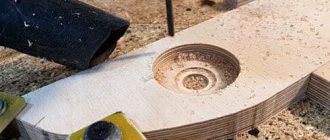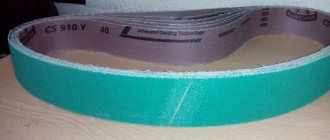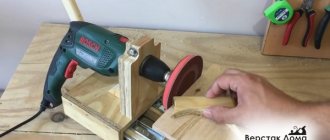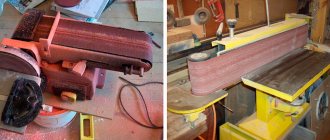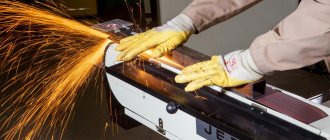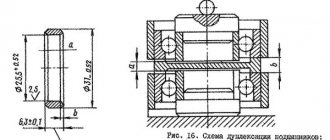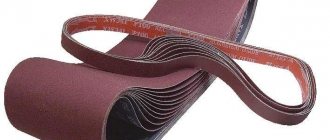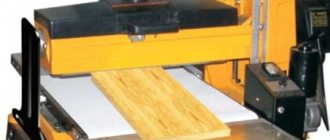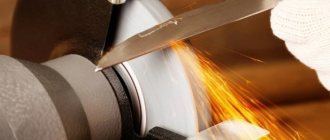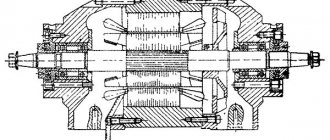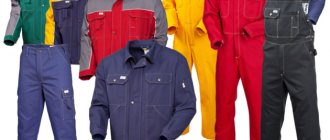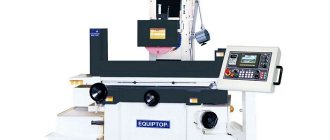DIY grinder pulley
The grinder pulley, after the motor itself, is one of the most expensive elements of a grinding machine. The finished part costs at least 2,000 rubles. However, craftsmen use prefabricated wooden structures for their homemade products. Let's briefly consider the sequence of turning a pulley and rollers from thick plywood on a CNC machine.
| Illustration | Description of action |
| Using a special algorithm, the machine begins to sequentially cut out layers of the product exactly to the specified dimensions. | |
| These are the blanks we got. Cut the remaining rings to size. | |
| From the resulting rings we assemble a pulley and barrels, and fasten the parts with glue. | |
| Using a grinding machine, we polish the bevels so that the tape holds tightly. | |
| We process the resulting structures with impregnation. |
Rollers, pulleys and other grinder accessories
We make pulleys and rollers from caprolon (polyamide-6) for the grinder. Caprolon has high impact strength, almost as good as aluminum. Tel./WhatsApp - 89377721731
1. You tell us (whatsap/tel.) what product you need and its sizes. You will also need your full name and delivery address; 2. We inform you of the bank card number and the total amount of the transfer; 3. After the funds have been credited, we will send you the parcel by Russian Post.
Delivery to the regions - from 350 rubles. up to 500r. (depending on distance). Russian Post.
Grinder rollers play an important role in the operation of the machine. They differ in purpose, design and size, and can be industrial or home-made.
A grinder, or tabletop belt sander, is designed for processing and finishing small flat parts, sharp edges, removing rust and old paint. In everyday life, it will help you sharpen a knife or scissors, straighten the blades of a meat grinder, or polish a part of a complex shape without disturbing the profile. You can also edit cutters and drills on it. Allows you to process wood, plastic, metal, stone and ceramics.
What does a homemade grinder consist of?
Let's look at the main components from which our homemade belt sanding machine is assembled.
Assembly drawing of the grinder
- Leading video
- Tension roller
- Driven roller
- Second driven roller
- Tensioner pulley lever
- Podruchnik
- Console
- Emphasis
- Frame
All components of the machine are easy to manufacture, and anyone can assemble it if desired. If you don’t have a welding machine, you can always negotiate with your neighbor for a small fee. Or allow you to use a homemade grinder if necessary. The grinder will be compact and not heavy.
Grinder from a grinder
One of the simplest options for a belt sander is to fix the sander in a wooden or metal structure. For this, an angular base is made. A hole is cut from below for the cable, and the sander is firmly fixed to the vertical wall of the base. All that remains is to make a work table and that’s it, you can start sharpening.
To glue the tape yourself, you will need glue, sandpaper of two “adjacent” types in terms of grit level, and a piece of fabric.
It is necessary to cut coarser sandpaper into strips of the required length and width. Then peel off the abrasive layer on both sides by 2-3 cm. Glue a piece of fabric to the cleaned edges with glue and let it dry. We cut out a “patch” from finer sandpaper and glue it to the fabric.
How to make rollers for a grinder – Manual Workshop
Pay attention to the possibility of adjustment. It will help compensate for possible inaccuracies in the process of welding the lever to the base of the grinder.
Expert opinion
Strebizh Viktor Fedorovich, leading construction foreman
When assembling the grinder yourself, it is important to position the rollers strictly perpendicular to each other to avoid distortions of the belt, which can lead to its breaks. If you want to clarify something, please contact me!
Grinder specification
Any belt sanding machine consists of a reliable frame and auxiliary parts. The main task when manufacturing a machine is to place the rollers in the same plane, otherwise the tape will constantly move to the side.
DIY grinder
You also need to pay attention to the speed of the drive. For this, a washing machine motor is perfect.
Before we begin production, we need to prepare:
- Square pipe 30x30x2 - 250 mm.
- Square pipe 25x25x1.5 - 1250 mm. Taking into account the cut.
- Channel No. 21 – 350 mm.
- Steel strip 50x8 – 700 mm. (With reserve). Or the eyes from the Gazelle spring earrings.
- Old door hinge.
- Sheet 170x190x4 for making a stop.
- Plywood sheet 500x200x8 mm.
- Bearings 201 – 9 pcs.
- Polypropylene couplings for 32 – 6 pcs.
- Polypropylene pipe PN20 – 250 mm.
- M8 hairpin – 1 pc.
- M12 hairpin – 1 pc.
- M8 nuts.
- Spring for tension arm.
- Angle No. 5.0 for mounting the engine to the frame.
- Motor from a washing machine.
Tensioner pulley lever
Making the lever is not difficult, just look at the photo and the assembly drawing, everything immediately becomes clear.
Pay attention to the possibility of adjustment. It will help compensate for possible inaccuracies in the process of welding the lever to the base of the grinder.
Expert opinion
Strebizh Viktor Fedorovich, leading construction foreman
To glue the tape yourself, you will need glue, sandpaper of two adjacent types in terms of grit level, and a piece of fabric. If you want to clarify something, please contact me!
Tape is still better
A belt grinder allows you to do everything a disk grinder can do, and much more. Therefore, next we will focus on how to make a belt sanding machine with your own hands. Amateurs, focusing on industrial designs, sometimes make very intricate grinders, see figure:
Homemade belt sanders
And this is justified: the design and kinematics of the belt grinder are very flexible, which makes it possible to successfully use scrap materials and old scrap metal. You just need to follow 3 principles:
- Do not do as in the second photo from the left: the abrasive side of the tape should only touch the workpiece. Otherwise, the abrasive will eat both the guide rollers and itself. The accuracy and cleanliness of processing during one work operation will be unpredictable;
- The design of the machine must ensure uniform tension of the belt, regardless of the nature of the operation performed;
- The speed of the belt must correspond to the nature of the operation being performed.
Kinematics and design
As mentioned above, there are many designs of grinders. When considering what and how to build a grinder for yourself, it is better to focus on industrial designs designed to be fully mechanized for precise and clean grinding of large-sized profiled parts: once it “sands” the blade of an airplane propeller or wind turbine properly, it can handle any other work.
Kinematic diagrams of grinders for the specified purpose are shown in Fig.:
Basic kinematic diagrams of belt grinding machines (grinders)
Pos. A is the most complex and perfect, with three rocker arms. If the length of the tension roller rocker arm is approx. 2 times less than the working one, then by adjusting the tension of the springs, it is possible to achieve uniform tension of the tape when the working rocker moves 20-30 degrees up and down. By tilting the bypass rocker, firstly, the machine is reconfigured for belts of different lengths. Secondly, in the same way you can quickly change the belt tension for different operations. The working branch of the belt can be any, except for the one running from the drive pulley to the tension roller, i.e. A grinder with 3 rocker arms is both horizontal and vertical.
The scheme with one misaligned rocker arm is used quite rarely in industry, because in principle, it does not allow achieving uniform tape tension. However, it gives accuracy that is quite sufficient at home and allows you to build a very good simple grinder.
What's good for what?
Now let's see what is possible to “squeeze” out of this or that circuit from the point of view of an amateur master. And then we’ll try to figure out how to make a grinder belt ourselves and do without custom-made turned parts.
Design features
The design of the grinder rollers is of great importance for work productivity.
For a homemade device, an electric motor with a nominal speed of 1500 per minute is most often used. With a slip rate of 9%, the actual rotation speed will be 1380–1400 rpm. Based on this, the dimensions of the parts are calculated. The drive roller deserves special attention. It is made massive in order to smoothly accelerate the belt to a given peripheral speed due to a significant moment of inertia. If you make the drive pulley from solid steel, it will turn with difficulty when starting. Therefore, it is made hollow or from duralumin grade D16 and higher. It is recommended to machine driven and tension rollers from light and hard duralumin, then there will be no need to make cavities.
The larger the diameter of the drive roller, the deeper the cavity should be.
Pulley drawing
The standard diameter of the drive pulley is 150 mm. The tension one is made with a size of 100 mm, and the other two are 70 mm each. Dimensions may vary slightly depending on the dimensions of the machine. The width of the parts corresponds to the size of the sanding belt with a small margin.
The generatrix of the drive pulley must be straight, otherwise the belt will bend along its entire length when rotating. It is reliably kept from sliding by the remaining rollers.
The speed of movement of the belt will depend on the diameter of the pulley. If the belt runs slowly, it will tear the material being processed. And from rapid sliding it will soon wear out. A simple rule to keep in mind is that hard parts and fine abrasive grains require high belt speeds.
Compact grinder with working pulley and tensioner
To avoid slipping of the sanding belt when the planes of the rollers do not coincide, a groove is made on the generating surface, corresponding in width and depth to the section of the belt. However, this design has a drawback: under heavy load, the tape slides onto the flange. A proven and reliable option is to use barrel rollers. In some cases, the products are covered with rubber material.
During installation on the grinder, you need to ensure that all the rollers are located in the same plane.
VIEW GRINDER from AliExpress →
When processing, it is necessary to ensure the roughness of the forming surface in the range of 1.25–2.5 Ra. Large values will lead to wear of the belt, and on a surface that is too smooth it will turn. The “barrels” are installed on the shafts using bearing supports. The bearing assemblies are sealed to protect them from debris and abrasive dust. Bearings will be required to be self-aligning, not lower than 6th accuracy class. Their load-bearing capacity must correspond to the drive speed and planned loads. The prefabricated structure is fixed to the axis through cotter pins or through a collar and a fastening kit. For the drive pulley, you need to make a keyway in the mounting hole for installation on the engine shaft key or hole for the goujon.
The tensioner roller is made movable. It has a support spring to tension the belt, compensate for runout on the pulley and rollers and sagging when the part is pressed. This way the tape will last longer and will not break.
The rollers must have a barrel-shaped profile to securely hold the rotating belt. The central part is made 2 mm higher than the edges.
Based on the connecting dimensions, a working drawing is drawn up, according to which the turner can produce parts.
Typical drawing of a roller
VIEW RUBBER ROLLER from AliExpress →
Tensioner and driven rollers
Made from propylene couplings, they are sold at any hardware store. Assembly drawing and step by step guide below.
Assembly drawing of the coupling
We assemble a package of couplings and D20 tubes onto the M12 stud; they serve as spacers between the bearings and install the bearings themselves. The photo below shows the entire assembly.
Step 1. Assembling the roller
Step 2. Tighten the nuts with a wrench
We pull together the assembled package into one whole. We process it with a grinder and a petal wheel on all sides, achieving a barrel-shaped shape.
In the same way we assemble the next two driven rollers. But we give the barrel shape only to the tension roller.
Collecting videos
The drive roller for the engine is made of plywood. Cut out 10 circles with a diameter of 85 mm. Mark the center and drill a hole with an 8 mm drill. We coat each disc with PVA glue. We collect it in a bag on an M8 stud and compress it from both ends through washers with nuts.
Let it dry overnight for further finishing. Next, drill a hole 24 mm deep. If you don't have a finger cutter, you can use any drill. In our case, the cone from the drill is not a hindrance.
Your motor shaft may be different from the drawing, but this is not a problem. The principle of fastening remains the same, only the dimensions will change, which can be measured with a special tool. Read how to use a caliper here.
After preparing the roller and shaft, you can begin finishing the drive pulley. Attach the motor to the platform, put on the drive pulley, turn on the motor and carefully sand the roller with a flap abrasive wheel.
After cleaning, the edges need to be beveled a little to get a barrel look.
Expert opinion
Strebizh Viktor Fedorovich, leading construction foreman
Often something breaks in it, the body or the anchor, or maybe a new, more powerful and convenient model just comes out, so the old one gathers dust somewhere in a box in the garage. If you want to clarify something, please contact me!
Schematic diagram of the grinder design and the principle of its operation
Before you begin selecting materials and components, it is important to understand the operating principle of the device.
Important! Some grinder parts will have to be purchased ready-made. Perhaps turn to the services of a turner.
There is nothing complicated in the design of the grinder from the mechanical side. It is important to determine the power of the unit and find components. In fact, the main element of the design is the motor and drive, which supplies torque to the rollers that rotate the belt. All elements can be made from metal, plywood, or even plastic. The photo shows a drawing of the grinder with dimensions.
Grinder device in the drawing
Let's look at the principle of operation of the grinder. With the help of a motor, a group of rollers is driven, one of which is the main one, or leading, the others are secondary. After turning on the device, the sanding belt begins to move. Using the regulators, you can shift the position of the rollers, which allows you to adjust the depth of tension and grinding and also its angle.
So, the main elements of the grinder are:
- Base.
- Electric motor.
- Straight roller with pulley.
- Tension rollers.
- Abrasive tape.
- Rack.
In addition, the design includes a rotating clamping mechanism.
Main components of the grinder
The unit, as we have already said, can be either manual or stationary. The design of a stationary device includes elements such as a rotary table with clamps, which is usually mounted on a workbench or stationary frame. The table can change the angle of inclination, rotate along its axis, and in some models – perpendicularly. The motor is driven either by a foot drive or by a drive motor that is attached directly to the tool on the frame. An old drill, grinder, or washing machine engine can serve as the “heart” of the grinder. The main thing is to ensure the necessary speed, which will allow you to process exactly those surfaces that you need.
Interesting fact! The power of the machine depends on the design of the belt mechanism and the volume of workpieces that you plan to process. The longer the sanding belt, the stronger the motor needs to be installed.
It is clear that over time the tension force of the tape may weaken; for this, options are provided for adjusting the tension system. This may be a spring clamp, and in some cases a regular bolt will help to adjust the height and angle of the rollers relative to each other.
Important! The rollers in the grinder must be installed strictly vertically relative to each other. Any change in the position of the rollers may cause the belt to break.
When thinking through the design, determine in advance how the work area will be cleaned of dust and eye protection. Typically, a folding acrylic glass or a stationary vacuum cleaner is used. You can see the design of this piece of equipment in industrial grinders.
Advice! Before deciding on the size of the belt and the width of the rollers, figure out for yourself what surfaces you plan to process, their dimensions and volume of work.
An example of the correct placement of rollers on a grinder
As we have already noted above, the issue of choosing a belt for a grinder is one of the most important. The speed and quality of surface treatment will depend on this. It is well known that sanding belts for grinders vary in length, width and degree of hardness (grain). Most often, the following tape sizes are used in machines of this type: 610, 915, 1230, 1600, 1830 mm in length, in width there are only two options -50 and 100 mm, however, experienced craftsmen can cut a tape of any width.
Important rules for choosing a belt for a grinder:
- The bottom fabric must be elastic in its structure. The fabric base better withstands surface tension.
- must withstand maximum angular speeds - at least 1500 rpm;
- the abrasive coating must be of high quality. Selected according to the material;
- the tensile strength must be at least 15%;
- the tape must be resistant to possible heating, which often occurs during long-term operation.
More information about the grinder device can be seen in this video:
Types of rollers for grinder
The grinder is a stationary device with an electric drive. The design consists of a frame, a base with mounting holes for installation on a workbench, a group of cantilever-mounted rollers with a sanding belt passed through them, a tension mechanism, a drive, a control panel and a table for fastening the workpiece. For safety, a folding glass made of transparent unbreakable material is used.
The output shaft of the electric motor is connected to the drive roller of the grinder. The rotation from it is automatically transmitted to the rest through a flexible connection. The position of the driven cylinders is adjustable, which allows you to grind surfaces to different depths. The tension mechanism is designed to compensate for tape stretching and possible slippage. It is located on one of the rollers, which is called tension.
Grinder rollers are considered critical parts. They are used to evenly tension the sanding belt and keep it from slipping.
Depending on the purpose they are:
- driven or leading;
- tension;
- slaves.
VIEW Grinder rollers from AliExpress from →
Console left
The console is easy to assemble. The parts are welded according to the drawing. First, one pipe must be bent using a manual pipe bender or simply clamped securely in a vice.
After welding, clean the seams and blacken them to prevent corrosion. Or you can paint it with enamel.
This is what you should end up with.
Homemade grinder assembled without tape
If you need to change the maximum grinding speeds, then, as an option, you can change the diameters of the rollers.
The diameter of the drive pulley is calculated using this formula: D=V x 1000 x 60 / π x N
Or use a frequency regulator to change the speed. There are many options for implementation, the main thing is the desire to do everything with your own hands and not be afraid of difficulties.
What are the best bearings for grinders?
both will start from a regular 220 network with a capacitor
I wanted to put number 1 so that it takes up less space. Can you say that 400W is enough for a 910 tape or is it better to put 1.1KW?
a support table with a ceramic cover and rollers has already been made, a tension roller with a position regulator is also already there, all that remains is to assemble it all on one of the engines\
I just have a roller from some part of the elevator, made of nitro from getinax, nito from pressed fiberglass, but the point is that the bearings are already pressed into it, I wanted to use it as a contact one, but only its edges are worn out and it turned out to be a barrel-shaped lathe; I don’t have the problem to sharpen it
The roller can be sanded on site. put the tape on and sand on the opposite side. the tape will spin the video without any problems.
I made the rollers from the timing belt tensioners of the TAZ-2112 car, of which there were a bunch of them
the engine was lying around the house the frame is made of aluminum and steel corners a bunch of bolts and all sorts of things that I dug up in my closet and in a friend’s garage
We didn’t have time to do any real work, we just did a few test runs in the garage, it turned out I was hoping that the narrow rollers would work, I realized I had to make something wider, the belt tensioner needs to be made more reliable so that there are no backlashes, it’s inconvenient that it’s very difficult to catch the position of the belt, probably because of the crooked drive roller and a small pitch of the screw for adjusting the roofing felts, you need to make a more barrel-shaped roller, in general, look at what happened, photos so that the Sergeant doesn’t swear, sting if you are interested in a larger one, tell me the skin
Source
